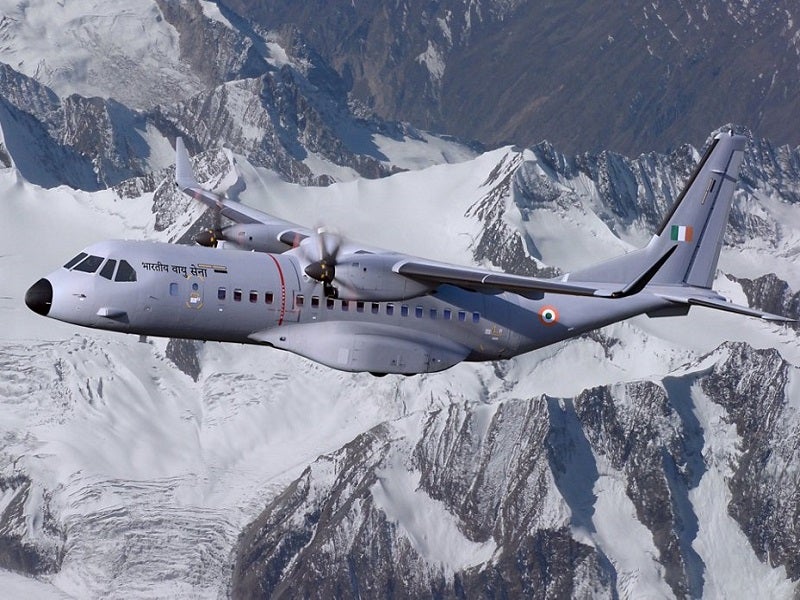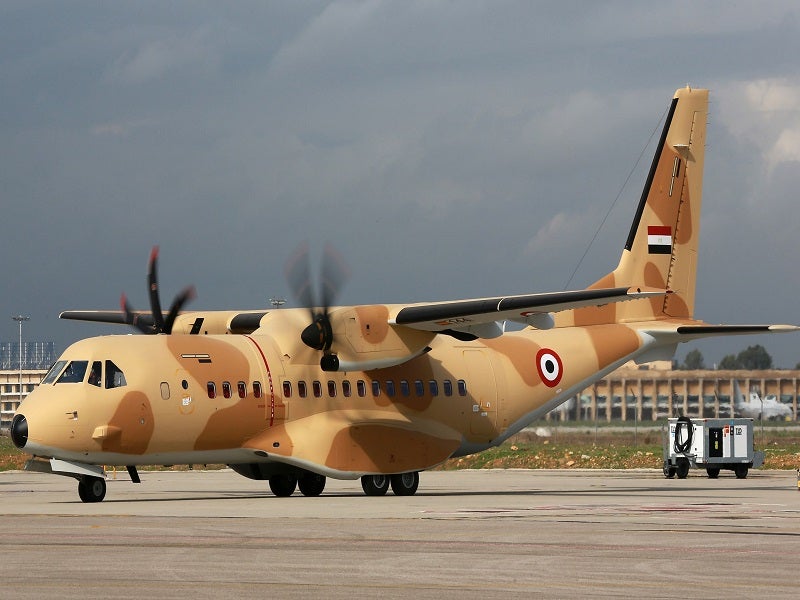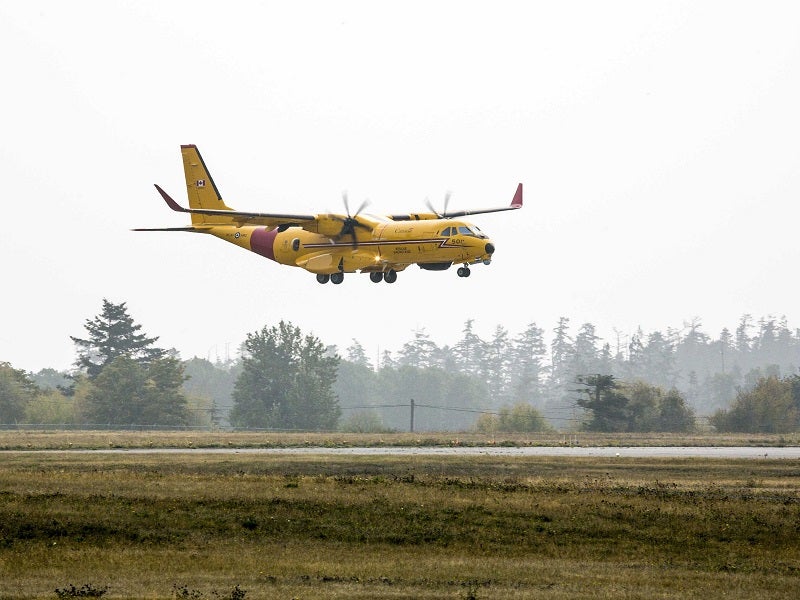The C-295M is a twin-turboprop transport aircraft manufactured by Airbus Defence and Space. It was previously manufactured by Construccionnes Aeronáuticas SA (CASA), a founder member of the EADS company based in Madrid.
The new C-295M is a stretched derivative of the CN-235 transporter, with a characteristic high-wing, rear-loader design. The aircraft is noted for its short take-off and landing capability on semi-prepared runways and for the large payload capacity of 9,250kg. The landing and take-off run of just 320m and 670m allow the aircraft access to runways close to operational or crisis areas or where supplies and troops are needed.
The aircraft has a flight endurance of up to 11 hours and load capacity of 71 troops, 50 paratroopers and five pallets.
The C-295 aircraft can be configured to support multiple missions including VIP Transport, medical evacuation, military operations, air-to-air refuelling as well as civic and humanitarian missions.
Airbus developed a removable air-to-air refuelling (AAR) kit, which refuelled a C295 from the Spanish Air Force during flight tests. The system also underwent proximity tests with the C295 and the Spanish Air Force F-18 in January 2020. Further, the first wet contacts of the aircraft were achieved during an AAR tanker flight test campaign in the same month of 2020.
The removable refuelling system of the aircraft weighs 1,500kg. It is equipped with up to three additional fuel tanks, an operator’s console, and a hose drum unit with 100ft-long deployable hose. Spain deployed two C295 tactical transport aircraft to deliver medical supplies to the Canary Islands to support the fight against the COVID-19 coronavirus, in March 2020.
C-295M transport aircraft programme
CASA announced the aircraft in June 1997 at the Paris Air Show at Le Bourget and the first production C-295 made its first flight in 1998. The aircraft was granted INTA certification for military operations, and DGAG and FAA (FAR part 25) certification in 1999.
In 1999, the Spanish Ministry of Defence placed a contract for nine C-295M transport aircraft. The aircraft entered service with the Spanish Air Force in November 2001 and delivery of the aircraft was completed in 2006. A further two aircraft were ordered in 2005, two in 2006 and two in 2007 to bring the fleet to 15.
International orders and deliveries
A total of 278 C-295 aircraft have been ordered by the customers worldwide. Of this total, 192 aircraft have been delivered and 190 are in operation.
The operators include Polish Air Force, UAE Navy, Brazilian Air Force, Royal Jordanian Air Force, Algerian Air Force and the Finnish Air Force, Egyptian Air Force, Ghana, Ivory Coast, Mali Air Force, Bangladesh, Indonesia, Philippines Air Force, Thailand, Vietnam, Kazakhstan Air Defence Force, Uzbekistan, Czech Republic, Portugal, Spain, Oman, Saudi Arabia, Canada, Chile, Colombia, Ecuador, and Mexico.
In April 2005, Venezuela ordered ten C-295 transport aircraft, but the USA denied the export licence necessary for the American content of the aircraft and the order was revoked. Portugal ordered 12 C-295 aircraft in February 2006, seven for military transport and five for maritime surveillance. Deliveries began in November 2008 and have been completed.
Poland ordered an additional two aircraft in October 2006 (delivered in September 2007) and two in October 2007 to bring its fleet to 12 aircraft. Five more aircraft, worth $262m, were ordered in July 2012. The first two were delivered in October 2012 and the third in December 2012. The remaining aircraft were delivered by 2013.
The Chilean Navy purchased three aircraft in October 2007. The Colombian Air Force ordered four aircraft in November 2007. The first two deliveries were made in June 2008, while the third and fourth were delivered in November 2008 and April 2009 respectively. Two more aircraft were ordered, one in September 2012 and the other in January 2013. Deliveries of all six aircraft were made.
The Czech Air Force ordered four C-295 aircraft in May 2009. Deliveries began at the end of 2009 and concluded in 2010. Airbus received a contract from the Czech Air Force to deliver two more C295 medium lifter aircraft in transport configuration in December 2019. The first of the two additional aircraft was delivered in May 2021. Another contract was signed for the upgrade of the four aircraft previously delivered to the Czech Air Force.
ADS CASA was teamed with Raytheon to offer the C-295 combined with the CN-235-300 for the US Army / Air Force joint cargo aircraft (JCA) competition. The C-27J was chosen in June 2007.
Indonesia placed an order for nine C-295 aircraft in February 2012. The first two were delivered to the Indonesian Air Force in September 2012.
Kazakhstan’s Ministry of Defence placed an order for two aircraft in March 2012. A Memorandum of Understanding (MoU) was also signed for six additional aircraft. Kazakhstan took delivery of the first two C295s in January 2013. The Border Service of Kazakhstan placed an order for one C295 aircraft in transport configuration in March 2019. Airbus delivered a total of nine C295s to Kazakhstan, as of September 2021.
Airbus Military received an order from Oman in May 2012 for the delivery of C-295 aircraft in tactical transports (five) and maritime patrol aircraft (three) configurations. All eight C-295 aircraft are in service.
Egyptian Air Force ordered six C295 transport aircraft in January 2013 and eight additional C-295 aircraft in July 2014. Egypt operates a fleet of 24 C-295 aircraft. Airbus received a contract from the Egyptian Air Force to provide performance-based support services for the C295 fleet for five years in April 2019.
Mexico placed an order of two C-295 aircraft for its Navy in October 2014. A total of 14 C-295 aircraft are in service with the Mexican forces.
Saudi Arabia ordered four C-295W aircraft in June 2015, with all aircraft currently in service.
The Philippines Air Force placed orders for four C-295 aircraft and received the fourth aircraft in November 2019.
Mali ordered a single unit of C-295W transport category aircraft in February 2016 and the aircraft is in service with the Mali Air Force. An additional C295 aircraft was ordered in transport configuration in December 2020. The order also includes integrated logistics support with spare parts for the two C295s, and training services.
The UAE made orders for C-295 medium transport aircraft in November 2017. Five C295s are operational with the UAE Air Force, as of September 2021.
Brazil ordered an additional C-295 search and rescue (SAR) aircraft in July 2014 and the delivery was made in June 2017. All 15 aircraft ordered by Brazil were delivered, as of September 2021.
Aviation financier and lessor Stellwagen placed an order for 12 C-295 medium transport aircraft in June 2017.
The first of 16 C-295 aircraft ordered by the Government of Canada in 2016 arrived in Canada in September 2020. Designated CC-295, the aircraft will meet the requirements of the Royal Canadian Air Force’s (RCAF) fixed wing search and rescue aircraft replacement (FWSAR) project. RCAF received a total of seven aircraft, as of September 2021.
Ireland ordered two C295s in maritime surveillance configuration in December 2019.
India signed a contract with Airbus Defence and Space to formalise an order of 56 C295s in September 2021. The first 16 aircraft will be delivered in fly-away condition over four years from the date of implementation of the contract. The aircraft will be assembled at the Airbus facility in Seville, Spain.
The remaining 40 aircraft will be manufactured and assembled by Tata Advanced Systems in India under an industrial partnership with Airbus. The Indian Ministry of Defence and Airbus also signed an offset contract under which the latter is obligated to purchase the eligible products and services from local partners in India.
C-295M cockpit and avionics
C-295M features glass cockpit with four large 152mm x 203mm (6in x 8in) Thales colour liquid crystal displays compatible with Night Vision Goggles (NVG). The flight deck is fitted with dual controls for the pilot and co-pilot. The aircraft is equipped with fully digital integrated TopDeck avionics suite supplied by Thales. Two head-up displays can also be fitted as an option.
The maritime patrol variant (MP Persuader) can be fitted with EADS CASA Fully Integrated Tactical System (FITS) mission system.
Aircraft for the UAE Navy are fitted with FITS, which consists of four multi-function consoles and integrates data from sensors including search radar, forward-looking infrared (FLIR), TV cameras or other sensors.
The communications suite includes two or three UHF/VHF radios, a single or dual HF radio and an audio control system. The C-295 is also fitted with a cockpit voice recorder (CVR), identification friend or foe (IFF) system, the flight data recorder (FDR) and an emergency locator transponder (ELT).
A dual Thales flight management system is fitted in the aircraft, which is controlled using two multifunction controller display units (MCDU), dual air data units type ADU 3000, dual attitude heading and reference systems (AHRS), two radar altimeters (radalt) and an optional Honeywell ground proximity warning system.
Other navigation equipment includes two multimode receivers (MMR), two automatic direction finders (ADF), one direction finder (DF) and two distance measuring equipment (DME) units. There are also three possible configurations for long-range and autonomous navigation, two integrated inertial navigation and global positioning systems (INS/GPS), two GPS or two GPS plus one INS/GPS.
The Honeywell RDR-I400C colour weather radar has search, beacon and vertical navigation ground mapping modes. Portuguese Air Force C-295s are fitted with Northrop Grumman AN/APN-241 colour weather radar.
The aircraft can be fitted with alternative communications and navigational systems to suit the customer country’s operational requirements. Optional equipment includes an enhanced terrain collision avoidance system (TCAS), tactical air navigation (TACAN), category II instrument landing system, a microwave landing system and satellite communications.
Cabin of C-295M
The aircraft features the longest unobstructed cabin with length of 12.7m, accommodating up to 71 seats. The main cabin can be fitted with two or three rows of foldable seats to accommodate 48 fully equipped paratroops or up to 75 troops. There are two paratroop doors, one on each side of the rear part of the cabin. The cabin is fully air conditioned and pressurised.
The cabin can be configured for medical evacuation missions for 27 litters (stretcher patients) and four medical staff. An alternative configuration accommodates an intensive care unit for 12 stretcher patients.
It can be fitted for mixed cargo and passenger transport, or for all cargo operations. A roller loading system is installed and a wide ventral door and cargo ramp in the upswept rear fuselage provide easy cargo access.
The cabin holds up to 57m³ of cargo and can accommodate up to three light vehicles, Land Rovers or equivalent, or five 2.24m × 2.74m (standard 88in × 108in) pallets.
Countermeasures
C-295M can be fitted with the Indra ALR-300V2B radar warner and BAE Systems ANALE-47 chaff / flares dispenser.
C-295M engines
The aircraft is powered by two Pratt & Whitney Canada PW127G turboprop engines, each rated at 1,972kW and at 2,177kW with auto power reserve. The engines drive six-bladed composite propellers, type HS-568F-5 developed by Hamilton Sundstrand. The blades, of 3.89m diameter, have autofeathering and synchrophasing.
The aircraft carries a 7,700l fuel load, giving a maximum range of 5,630km. It can be equipped with an optional probe for probe and drogue refuelling, so the range can be extended by in-flight refuelling.
Landing gear details
The aircraft is fitted with tricycle-type retractable landing gear designed by Messier-Dowty. The landing gear is designed to allow operation from semi-prepared runways, down to runway class CBR-2, and is equipped with levered suspension and oleo-pneumatic shock absorbers.
The main landing gear, each equipped with two wheels in tandem, is installed in fairings on the underside of the fuselage. The gear is fitted with Dunlop hydraulically operated differential disc brakes and an anti-skid system. The steerable nose wheel is fitted with twin wheels.
Improved technologies
The tactical capabilities of the aircraft have been improved with Collins Aerospace Pro Line Fusion integrated avionics system, which enables easier operation and reduced workload on pilots. It improved the avionics with intuitive Human Machine Interface (HMI) with touchscreen controls.
Its short take-off and landing capability allows operations from approximately 670m (2,200ft) of soft and rough unprepared airstrips. It is capable of low-level flight for tactical missions, at speeds down to 110kt.




